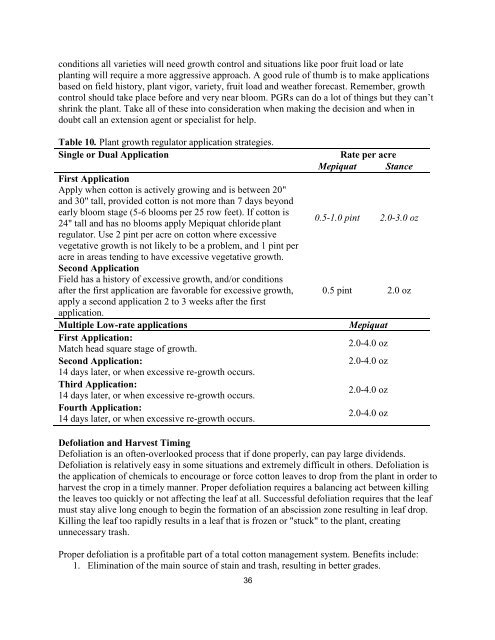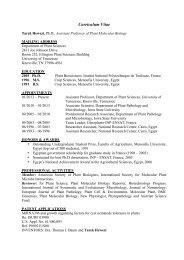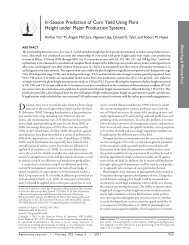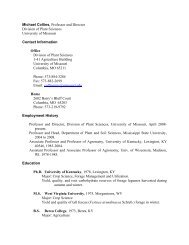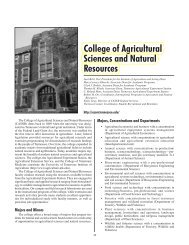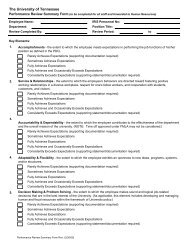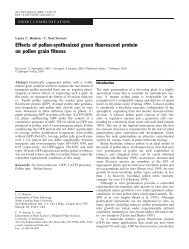CATEGORIES OF FORAGE CROPS - Department of Plant Sciences
CATEGORIES OF FORAGE CROPS - Department of Plant Sciences
CATEGORIES OF FORAGE CROPS - Department of Plant Sciences
Create successful ePaper yourself
Turn your PDF publications into a flip-book with our unique Google optimized e-Paper software.
conditions all varieties will need growth control and situations like poor fruit load or late<br />
planting will require a more aggressive approach. A good rule <strong>of</strong> thumb is to make applications<br />
based on field history, plant vigor, variety, fruit load and weather forecast. Remember, growth<br />
control should take place before and very near bloom. PGRs can do a lot <strong>of</strong> things but they can’t<br />
shrink the plant. Take all <strong>of</strong> these into consideration when making the decision and when in<br />
doubt call an extension agent or specialist for help.<br />
Table 10. <strong>Plant</strong> growth regulator application strategies.<br />
Single or Dual Application<br />
First Application<br />
Apply when cotton is actively growing and is between 20"<br />
and 30" tall, provided cotton is not more than 7 days beyond<br />
early bloom stage (5-6 blooms per 25 row feet). If cotton is<br />
24" tall and has no blooms apply Mepiquat chloride plant<br />
regulator. Use 2 pint per acre on cotton where excessive<br />
vegetative growth is not likely to be a problem, and 1 pint per<br />
acre in areas tending to have excessive vegetative growth.<br />
Second Application<br />
Field has a history <strong>of</strong> excessive growth, and/or conditions<br />
after the first application are favorable for excessive growth,<br />
apply a second application 2 to 3 weeks after the first<br />
application.<br />
Multiple Low-rate applications<br />
First Application:<br />
Match head square stage <strong>of</strong> growth.<br />
Second Application:<br />
14 days later, or when excessive re-growth occurs.<br />
Third Application:<br />
14 days later, or when excessive re-growth occurs.<br />
Fourth Application:<br />
14 days later, or when excessive re-growth occurs.<br />
Rate per acre<br />
Mepiquat Stance<br />
0.5-1.0 pint 2.0-3.0 oz<br />
0.5 pint 2.0 oz<br />
Mepiquat<br />
2.0-4.0 oz<br />
2.0-4.0 oz<br />
2.0-4.0 oz<br />
2.0-4.0 oz<br />
Defoliation and Harvest Timing<br />
Defoliation is an <strong>of</strong>ten-overlooked process that if done properly, can pay large dividends.<br />
Defoliation is relatively easy in some situations and extremely difficult in others. Defoliation is<br />
the application <strong>of</strong> chemicals to encourage or force cotton leaves to drop from the plant in order to<br />
harvest the crop in a timely manner. Proper defoliation requires a balancing act between killing<br />
the leaves too quickly or not affecting the leaf at all. Successful defoliation requires that the leaf<br />
must stay alive long enough to begin the formation <strong>of</strong> an abscission zone resulting in leaf drop.<br />
Killing the leaf too rapidly results in a leaf that is frozen or "stuck" to the plant, creating<br />
unnecessary trash.<br />
Proper defoliation is a pr<strong>of</strong>itable part <strong>of</strong> a total cotton management system. Benefits include:<br />
1. Elimination <strong>of</strong> the main source <strong>of</strong> stain and trash, resulting in better grades.<br />
36


